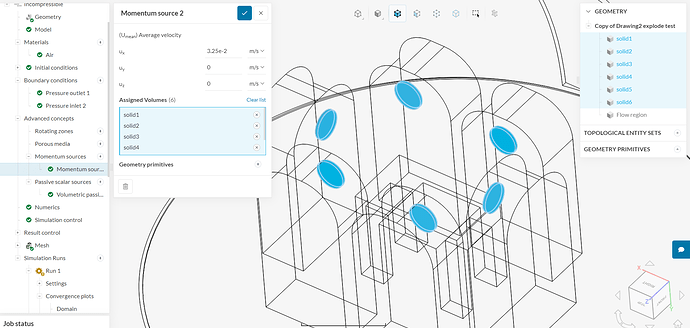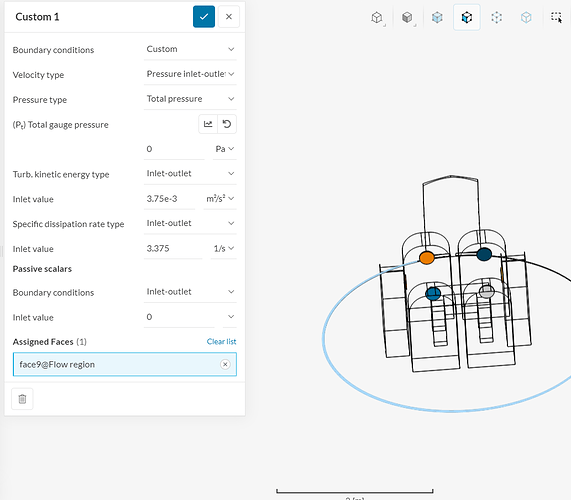Hi Everyone,
I’m trying to model airflow in an enclosed shelter, in which six people’s exhalation acting as momentum sources and as passive scalars. Although the mesh was successful, I’m running into problems with the simulation.
First off, the simulation runs to the maximum allowable time, even though the run time estimation is 55-83 minutes. I have tried to combat this by making the mesh coarser, but haven’t been successful.
Additionally, I received an error of detected divergence of the linear system solver. It was recommended that I lower the relaxation factor of T1. Therefore, I lowered the relaxation factor of T* from 0.3 to 0.2. I did this because I received an error of linear divergence.
After making these adaptations, I ran the model one more time, but the run cancelled itself at 500 minutes. I looked at the results, and concerningly, it appears that airflow is only happening at the surfaces of the momentum sources and not throughout the entire enclosure.
Any help as to how to fix these issues would be much appreciated. Here is a link to the project: SimScale
Allison
Hi,
From looking at the solver log, the simulation is having difficulties to converge for pressure and T1. It’s constantly running 1000 iterations for the pressure/T1 solvers and the simulation eventually times out.
If I may ask, what is the scenario that you are trying to capture with the current assignments for pressure inlet and outlet? They are right next to each other, very close to the ground - the configuration looks unusual to me.
Cheers
Hey @RicardoParis
It’s definitely a weird configuration. This is supposed to mimic an enclosed dining structure where occupants would sit inside to stay warm. It’s a plastic structure, so it’s airtight, except for a small area where the plastic bubble sits on the ground. That’s what I was trying to model.
Thank you so much for taking the time to look at this. What you’re saying about the solver logs is helpful. Is it possible to model the pressure to the ambient air a better way? If you have any suggestions on how to better model this, feel free to leave your idea in the comments.
Allison
It’s definitely a good idea to review the settings. Currently all momentum sources are generating flux in the x-direction (which is probably unintended):
Some other ideas:
- Using a single inlet/outlet with a custom boundary condition that allows that. E.g.:
-
Trying to run with “Automatic” relaxation, under numerics.
-
I still think the inlet/outlet faces are unnecessarily complex. It wouldn’t hurt to have a simpler face.
Hi @RicardoParis
This was really helpful! I was able to get the simulation to run and converge. In your image above, would you be able to tell me what the values/numbers represent, and tell me where the numbers come from? Specifically where the value for the inlet value for turb. kinetic energy type and for the specific dissipation rate type comes from?
I’m assuming they are just default values, but was also curious if they were a known value or constant variable.
Thank you for the clarity! And seriously thank you for your help above!
Allison
Hi Allison, glad to hear!
You are correct, those values are default. If you’d like to use a “more educated” guess for the turbulence, then this article is a good starting point: Defining Turbulent Boundary Conditions
Cheers


